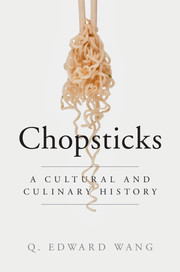Book contents
- Frontmatter
- Dedication
- Contents
- Acknowledgments
- List of Plates
- Timeline
- Map of East Asia
- 1 Introduction
- 2 Why chopsticks? Their origin and original function
- 3 Dish, rice or noodle? The changing use of chopsticks
- 4 Forming a chopsticks cultural sphere: Vietnam, Japan, Korea and beyond
- 5 Using chopsticks: customs, manners and etiquette
- 6 A pair inseparable: chopsticks as gift, metaphor and symbol
- 7 “Bridging” food cultures in the world
- Conclusion
- Glossary
- Bibliography
- Index
- Plate section
- References
5 - Using chopsticks: customs, manners and etiquette
Published online by Cambridge University Press: 05 February 2015
- Frontmatter
- Dedication
- Contents
- Acknowledgments
- List of Plates
- Timeline
- Map of East Asia
- 1 Introduction
- 2 Why chopsticks? Their origin and original function
- 3 Dish, rice or noodle? The changing use of chopsticks
- 4 Forming a chopsticks cultural sphere: Vietnam, Japan, Korea and beyond
- 5 Using chopsticks: customs, manners and etiquette
- 6 A pair inseparable: chopsticks as gift, metaphor and symbol
- 7 “Bridging” food cultures in the world
- Conclusion
- Glossary
- Bibliography
- Index
- Plate section
- References
Summary
Another function of the two chopsticks together, that of pinching the fragment of food; to pinch, moreover, is too strong a word, too aggressive; for the foodstuff never undergoes a pressure greater than is precisely necessary to raise and carry it; in the gesture of chopsticks, further softened by their substance – wood or lacquer – there is something maternal, the same precisely measured care taken in moving a child: a force no longer a pulsion; here we have a whole demeanor with regard to food … the instrument never pierces, cuts, or slits, never wounds but only selects, turns, shifts.
Roland Barthes, Empire of Signs, 16.Der Mensch ist was es isst (a man is what he eats).
German proverbIn ancient times, people used both spoons and chopsticks to eat food, as recorded in histories and biographies. Korea also followed this custom. However, when the Central Plain [China] was in chaos, hundreds and thousands of military officers left and went east [to Korea]. When eating food, regardless of how it was cooked, they only used chopsticks, never a spoon. I don’t know when this way of eating began. It is said that Ming Emperor Taizu [Zhu Yuanzhang] once vowed that before he defeated Chen Youliang, he would not dare to use a spoon to eat and drink. He wanted to demonstrate his resolve. From then on, eating without a spoon gradually became adopted as a custom. However, I do not know whether this story is believable.
- Type
- Chapter
- Information
- ChopsticksA Cultural and Culinary History, pp. 93 - 119Publisher: Cambridge University PressPrint publication year: 2015



